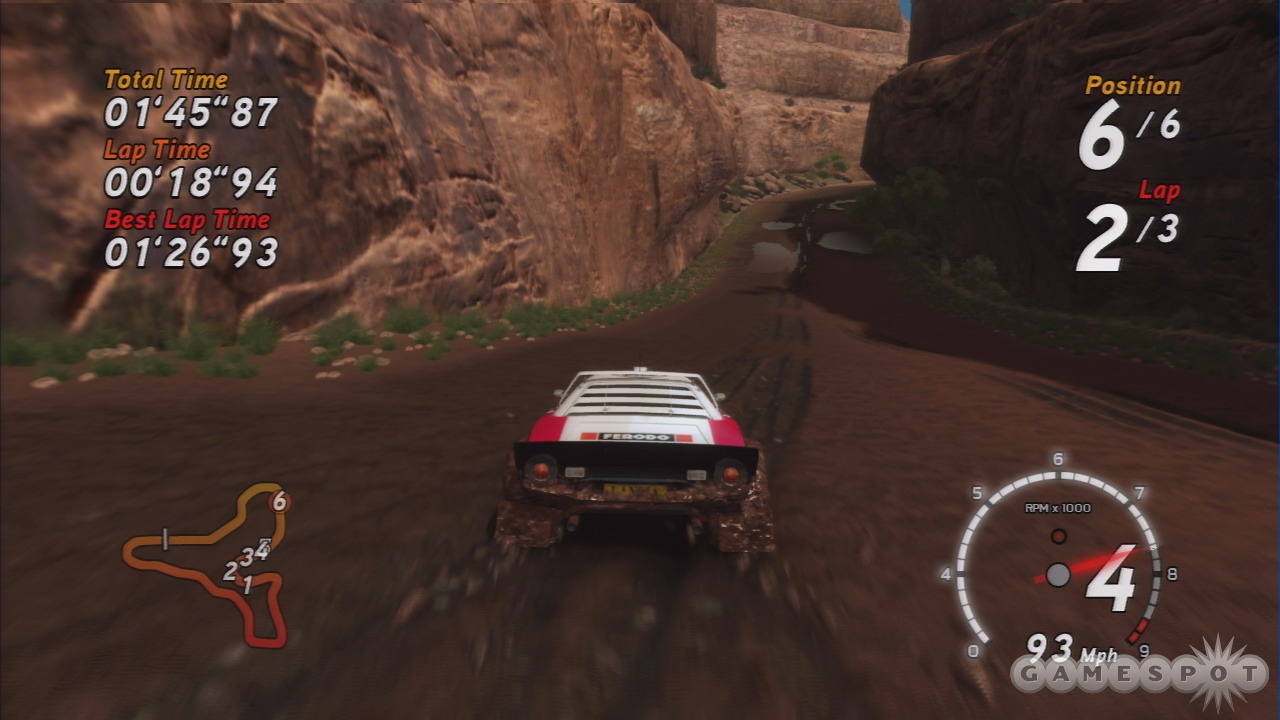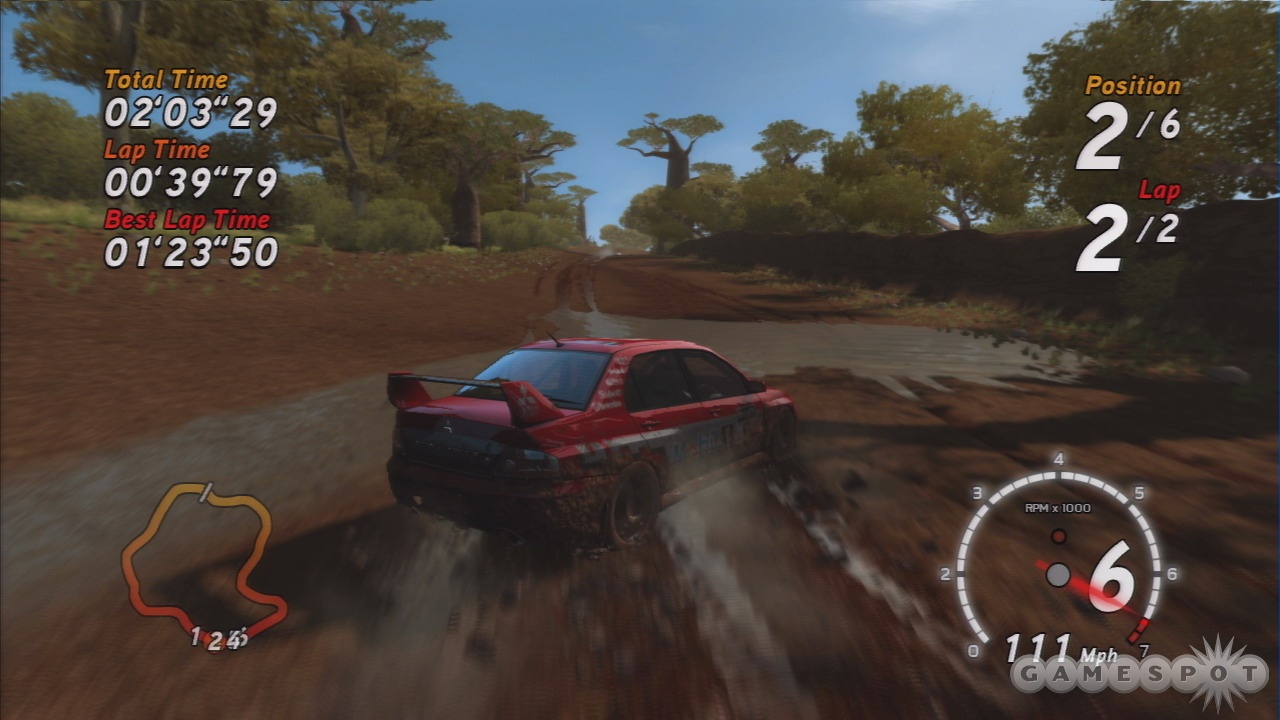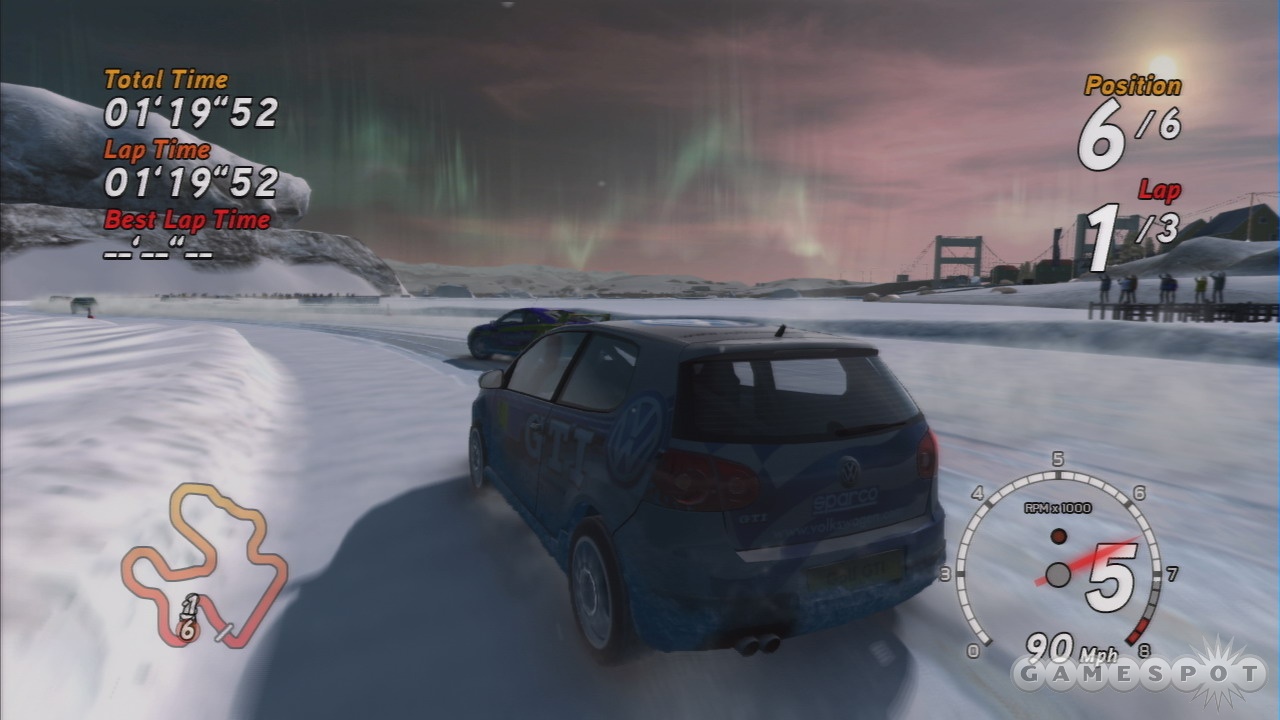Sega Rally Championship 2 for the Dreamcast was the last time North America saw a release of a Sega Rally game, back in 1999. Now, eight years later, the franchise is back in Sega Rally Revo for the PlayStation 3 and Xbox 360, and you may be shocked by how little things have changed. Sure, the technology has leapt over a skyscraper or two, but when it comes down to the fundamental arcade style of driving that this series was known for, Revo is like a visit from the past. This actually feels like the sort of game you should be driving in some monolithic arcade cabinet, with powerslide-heavy driving mechanics and physics that are geared decidedly toward keeping you moving forward and moving fast at all times. Is it fun? Absolutely, though how long it will remain fun depends entirely on how well you get on with the game's scant list of available tracks and modes.

Your first impression of Sega Rally Revo is likely to be the one you'll keep all throughout your time with the game, because for as much as things change in the game, they ultimately stay the same. The second you get on a track, you'll know that this is pure arcade driving. Cars are incapable of going off track, with invisible barriers causing vehicles to bounce off everything from trees to minor shrubs. Tight, accurate, frequent powerslides are the name of the game, no matter what surface you might be driving on. And there is a wide variety of surfaces on display. From mud-bogged jungles to sandy beaches to the icy, snowy mountains, you'll encounter all manner of terrain as you drive.
The terrain is more than window dressing. As drivers race around the track, they're digging up the dirt and snow and whatever else, creating big tears in the track that will actually affect your car's handling when you drive through them. This is where the game's one element of strategy comes into play. These treads are often created over the ideal driving lines. So what do you do? Drive through the harsher portions of the track to keep the proper line? Or take the less beaten path and hope for the best?
As impressive as that notion is, it doesn't necessarily amount to a whole lot. You can get by either way and still perform reasonably well. You'll certainly feel the difference in the track depending on how torn up the surface is, especially if you're playing on the 360, where the force feedback does an absolutely phenomenal job of differentiating the feel of each surface (PS3 owners may want to invest in the Logitech driving wheel, or wait for the DualShock 3 to come around, as the lack of force feedback is a real bummer in this version). It's arguably more important to just get to know the tracks and make precise turns than it is to pay a whole lot of attention to where the torn up track is, especially if you choose the off-road setup prior to a race; the other option, "road," gives you higher speed on flat surfaces, but is ultimately less useful overall. Getting to know the tracks probably won't take you too long, as there are only 23 of them spread across five different environments, and several of those are reverse versions of existing tracks.
Getting a feel for each track takes some time, and when you pull off those really tight, accurate slides around snow-laden turns, it's a highly satisfying feeling. However, the challenge isn't all reliant on your skill, at least not in the offline game. The computer opponents in Sega Rally Revo are a tough lot, almost irritatingly so. The main issue with the game's artificial intelligence is that it's severely rigid. AI drivers stubbornly refuse to move off their racing lines, even when you're banging into them at high speeds. And yet, on the flipside, they have no issue bopping into you and knocking you into a corner the second you try to pass them. The second they do, they move right back onto their natural line and stay put. The AI also has a tendency to just decide when it wants to win, often blazing by you at crazy speeds not long before the end of a race. Once you get good at cornering, you can start taking the AI to task, but small screw-ups usually amount to you getting hosed for the rest of the race.

One thing that might stick out to some of you about how Revo plays is just how similar it is to the older Sega Rally games. Apart from the dynamic track deformation, Revo really does feel just like old-school Sega Rally, and that's both a blessing and a curse. Fans of the older games are likely to get giddy the second they start powersliding like a nutjob around crazy turns. By the same token, with so many advances in the racing genre over the last couple of years, Revo can't help but feel a bit like old hat at this point. It's fun, certainly, but not exactly anything special, and the hyper-floaty feel of the cars is probably going to drive some people out of their minds. It's almost as if the game is relying solely on the deformable track mechanic to lift its somewhat archaic driving mechanics up to the level of games like Dirt and Motorstorm. But that feature isn't really enough to carry a game all by its lonesome. Again, the gameplay is fun, but in a real blast-from-the-past kind of way.
Sega Rally Revo offers a few different modes of play. Apart from the standard quick race mode, there is a time trial mode where you can try to beat the best leaderboard times from around the world. The cool thing about this mode is that after any race, you have the option to upload your ghost car data to the online server, and in turn, you can download any players' ghost data to race against while you try to beat their time.
The main mode is the championship mode. There are three championship tiers, each tied to the three car classes in the game. You start out with the premier league, which consists of standard rally rides like the Subaru WRX STi and Mitsubishi Lancer Evo IX, then move on to the modified league, with cars like the VW Golf GTI and Grande Punto Rally, then finally hit the masters league, and drive rally classics such as the Lancia Super Delta HF Integrale and Lancia Stratos. Each league has several unlockable cars as well, many of which are often much faster than the default rides (though at the same time, often more challenging to handle). With there being such a limited number of tracks, you end up repeating a lot of them again and again as you progress through each championship, though with the differences in speed between car classes, each step upward often results in a somewhat different-feeling race.
Finally, there is multiplayer. Two players can play head-to-head in split-screen play, and up to six can race online. The online options aren't terribly deep, with just the basic ranked and player matches available. However, when creating player matches, the host can design a custom championship of sorts, laying out an order of up to six different tracks to play through in a row. In both versions of the game, the online mode performed pretty well, with only minor bouts of lag that caused opponent cars to skip around the track a bit.

Graphically, Sega Rally Revo is extremely impressive, thanks in no small part to that dynamic track deformation feature. All the tire tracks are left in real time, and the sheer dynamics of how the terrain deforms over time are a bit staggering. Along the way, your car will get absolutely caked in mud and dirt, until you hit a puddle, at which point you'll see a great deal of that dirt wash right off. Whether dirty or clean, the car models look incredible. Though there aren't a ton of cars in the game, each featured model is gorgeously detailed. The one slight disappointment is that there's no manner of damage modeling in the game. While no one would expect anything too crazy in an arcade-oriented game like this, some basic body damage would have been a nice touch. Incidentally, you won't see much graphical difference between the PS3 and 360 versions of the game. The frame rate mostly stays at a steady 30 frames per second on both, and there's little difference in car or track detail between the two. The only real point of contention between the two would be the aforementioned rumble capabilities of the 360.
Sega Rally Revo is nothing revelatory, but it is a more-than-solid arcade racer with plenty of familiar licensed cars, some tight and challenging track designs, and enjoyable online options. You can't help but feel that, with all the great racers that have recently hit both systems, Revo is just a bit behind the curve. As enjoyable as the gameplay is, its narrow focus on constant powersliding and lack of track variety may wear thin on some players. Still, this is a game worth at least trying for any fan of arcade racers, especially if you dug any of the older Sega Rally games.